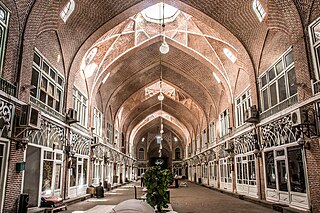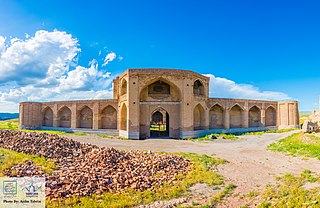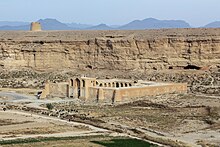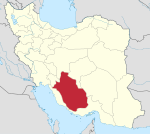
The Arg-e Bam, located in the city of Bam, Kerman Province of southeastern Iran, is the largest adobe building in the world. The entire building was a large fortress containing the citadel, but because the citadel dominates the ruins, the entire fortress is now named Bam Citadel.

Qom Province is one of the 31 provinces of Iran with 11,237 km², covering 0.89% of the total area of the country. Its capital is the city of Qom. The province is in the central part of the country and was formed from part of Tehran Province in 1995.

A bazaar or souk is a marketplace consisting of multiple small stalls or shops, especially in the Middle East, the Balkans, North Africa and South Asia. They are traditionally located in vaulted or covered streets that had doors on each end and served as a city's central marketplace.

A caravanserai was a roadside inn where travelers (caravaners) could rest and recover from the day's journey. Caravanserais supported the flow of commerce, information and people across the network of trade routes covering Asia, North Africa and Southeast Europe, most notably the Silk Road. Often located along rural roads in the countryside, urban versions of caravanserais were also historically common in cities throughout the Islamic world, and were often called other names such as khan, wikala, or funduq.

Gonabad is a city in the Central District of Gonabad County, Razavi Khorasan Province, Iran, serving as capital of both the county and the district.

The Bazaar of Tabriz is a historical market situated in the city center of Tabriz, Iran. It is one of the oldest bazaars in the Middle East and the largest covered bazaar in the world. It is one of Iran's UNESCO World Heritage Sites.

The Rayen Castle is a historic adobe fortress situated on the outskirts of the Hezar Masjed Mountains, about 100 kilometers south of Kerman province, Iran. The castle and the mudbrick city it protects display numerous architectural elements and design strategies recognized as hallmarks of Iranian citadels. The complex is well preserved despite numerous natural disasters that have destroyed similar structures nearby, including Arg-e Bam, which was destroyed in an earthquake in December 2003.

Naqsh-e Jahan Square, also known as the Shah Square prior to 1979, is a square situated at the center of Isfahan, Iran. Constructed between 1598 and 1629, it is now an important historical site, and one of UNESCO's World Heritage Sites. It is 160 metres (520 ft) wide by 560 metres (1,840 ft) long. It is also referred to as Shah Square or Imam Square. The square is surrounded by buildings from the Safavid era. The Shah Mosque is situated on the south side of this square. On the west side is the Ali Qapu Palace. Sheikh Lotf Allah Mosque is situated on the eastern side of this square and at the northern side Qeysarie Gate opens into the Isfahan Grand Bazaar. Today, Namaaz-e Jom'eh is held in the Shah Mosque.

Old City or Inner City is the historical core of Baku, the capital of Azerbaijan. The Old City is the most ancient part of Baku, which is surrounded by walls. In 2007, the Old City had a population of about 3,000 people. In December 2000, the Old City of Baku, including the Palace of the Shirvanshahs and Maiden Tower, became the first location in Azerbaijan to be classified as a UNESCO World Heritage Site.

Khan al-Umdan is the largest and best preserved caravanserai in Acre, Israel. Located in the Old City of Acre, it is one of the prominent projects constructed during the rule of Ahmed Jezzar Pasha in Galilee, under the Ottoman era.

Izadkhast is a city in the Central District of Abadeh County, Fars province, Iran, and serves as the administrative center for Izadkhast Rural District. It is the first city in Fars on the Isfahan-Shiraz Highway.

The Shushtar Historical Hydraulic System is a complex irrigation system of the island city Shushtar from the Sassanid era. It consists of 13 dams, bridges, canals and structures which work together as a hydraulic system.

Iraj Castle is a fortification built in 4th or 5th century AD in the central region of Ray, Sasanian Empire, near modern-day Asgarabad-e Abbasi, Iran. The monument is known for its peculiar design: large defensive walls with embedded rooms and arches, with towers at regular intervals, enclosing a vast empty interior of 190 hectares.

Beit Achiqbash ; is an old Aleppine courtyard mansion built in the mid 18th Century by Qarah Ali (Karaly), a wealthy Christian merchant.

The Complex of Izadkhast is located in Izadkhast in the Fars Province of Iran, roughly 135km south of Isfahan. It is a historical complex listed in the UNESCO World Heritage Tentative List. The complex consists of the Izad-khast Castle and old ruined town, the Izadkhast Caravanserai roadside inn, and a Safavid-period bridge. The complex is located on a natural base with the castle built on a bedrock to protect it from foreign attacks. The architecture of the complex displays unique characteristics to Izadkhast.

The Izad Khast Castle is located in Izadkhast in the Fars Province, central Iran. The castle was built during the Sassanid Empire and functioned as fortified walled city on the ancient Silk Road that ran through central Iran. It is the second largest adobe building in the world after Arg-e Bam.

Salasel Castle, is a historical fortress and World Heritage Site. It's part of Shushtar Historical Hydraulic System, located in the island city Shushtar, Khouzestan, Iran from the achaemenid era. Salasel Castle was registered on UNESCO's list of World Heritage Sites in 2009 and is Iran's 10th cultural heritage site to be registered on the United Nations' list together with the 12 other historical bridges, dams, canals, and buildings as Shushtar Historical Hydraulic System. The castle is situated on the top of a mountain and features multiple levels, secret tunnels, and various defensive structures, including walls and towers.

Jamalabad Caravanserai is a historical caravanserai in Jamalabad, near Mianeh, Iran. The building was originally constructed in Ilkhanate era, but was repaired during the reign of Abbas II.
The Persian Caravanserai is a UNESCO World Heritage site composed of 54 different caravanserais.






























